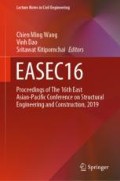Abstract
Delamination is one of the serious types of deterioration in reinforced concrete structures. It could cause concrete spalling, exposed steel bars, and ultimately affects the structural integrity of concrete structures. Infrared thermography (IRT) is a non-destructive technique which could potentially detect the delamination by capturing thermal contrast (∆T) on concrete surface caused by the heat flow disruption within the concrete due to subsurface anomalies. However, the optimum time and environmental conditions for IRT data collection are still unclear. In this study, an experimentally validated numerical model was developed to investigate the effect of a range of environmental conditions and defect characteristics on the IRT inspection outcomes. The results show that, under direct solar irradiation, the total heat flux input plays an important role in the development of thermal contrast ∆T instead of flux rate. Furthermore, delamination depth and size are two critical parameters that affect IRT results.
Access this chapter
Tax calculation will be finalised at checkout
Purchases are for personal use only
References
Abdel-Qader I, Yohali S, Abudayyeh O, Yehia S (2008) Segmentation of thermal images for non-destructive evaluation of bridge decks. NDT and E Int 41:395–405
Adams TM, Pincheira JA, Huang Y-H (2002) Assessment and rehabilitation strategies/guidelines to maximize the service life of concrete structures
Aggelis D, Kordatos E, Soulioti D, Matikas T (2010) Combined use of thermography and ultrasound for the characterization of subsurface cracks in concrete. Constr Build Mater 24:1888–1897
ASTM AD (2013) 4788: standard test method for detecting delaminations in bridge decks using infrared thermography. ASTM International, West Conshohocken, Pennsylvania
Blundell S, Blundell K (2006) Concepts in thermal physics (comprehensive assessment of water management in agriculture)
Gucunski N, Council NR (2013) Nondestructive testing to identify concrete bridge deck deterioration. Transportation Research Board
Guettala A, Abibsi A (2006) Corrosion degradation and repair of a concrete bridge. Mater Struct 39:471–478
Hiasa S, Birgul R, Catbas FN (2017) Investigation of effective utilization of infrared thermography (IRT) through advanced finite element modeling. Constr Build Mater 150:295–309
Hiasa S, Birgul R, Matsumoto M, Catbas FN (2018) Experimental and numerical studies for suitable infrared thermography implementation on concrete bridge decks. Measurement 121:144–159
Ishikawa M, Hatta H, Utsunomiya S (2013) Effects of heating duration on pulse phase thermographic non-destructive testing. Infrared Phys Technol 61:216–223
Jana D (2007) Delamination: a state-of-the-art review. In: Proceedings of the twenty-ninth Conference on Cement Microscopy Quebec City, PQ, Canada, pp 135–167
Kee S-H, Oh T, Popovics JS, Arndt RW, Zhu J (2011) Nondestructive bridge deck testing with air-coupled impact-echo and infrared thermography. J Bridge Eng 17:928–939
Kehlbeck F (1975) Einfluss der sonnenstrahlung bei brückenbauwerken. Werner-Verlag
Kylili A, Fokaides PA, Christou P, Kalogirou SA (2014) Infrared thermography (IRT) applications for building diagnostics: A review. Appl Energy 134:531–549
Maierhofer C, Arndt R, Röllig M (2007) Influence of concrete properties on the detection of voids with impulse-thermography. Infrared Phys Technol 49:213–217
Maierhofer C, Brink A, Röllig M, Wiggenhauser H (2003) Detection of shallow voids in concrete structures with impulse thermography and radar. NDT E Int 36:257–263
Maizuar M, Zhang L, Miramini S, Mendis P, Thompson RG (2017) Detecting structural damage to bridge girders using radar interferometry and computational modelling. Struct Control Health Monit 24:e1985
Maldague X (2001) Theory and practice of infrared technology for nondestructive testing
Kafle B et al (2017) Monitoring the dynamic behavior of the Merlynston creek bridge using interferometric radar sensors and finite element modeling. Int J Appl Mech 9(01):1750003
Tuttle R S (2005) Condition analysis of concrete bridge decks in Utah
Vaghefi K, Melo e Silva H, Harris D, Ahlborn R (2011) Application of thermal IR imagery for concrete bridge inspection. In: PCI national bridge conference, PCI/NBC, Salt Lake City: UT (USA), pp 1–12
Washer G, Fenwick R, Bolleni N (2010) Effects of solar loading on infrared imaging of subsurface features in concrete. J Bridge Eng 15:384–390
Raja BNK, Miramini S, Duffield C, Sofi M, Mendis P, Zhang L (2020) The influence of ambient environmental conditions in detecting bridge concrete deck delamination using infrared thermography (IRT). Struct Control Health Monit 27(4):e2506
Washer G, Fenwick R, Bolleni N, Harper J (2009) Effects of environmental variables on infrared imaging of subsurface features of concrete bridges. Transp Res Rec: J Transp Res Board 2108(1):107–114
Watase A, Birgul R, Hiasa S, Matsumoto M, Mitani K, Catbas FN (2015) Practical identification of favorable time windows for infrared thermography for concrete bridge evaluation. Constr Build Mater 101:1016–1030
Acknowledgements
The authors wish to thank the Australian Research Council (ARC IH150100006), Higher Education Commission (HEC), Pakistan and The University of Melbourne for their support.
Author information
Authors and Affiliations
Corresponding author
Editor information
Editors and Affiliations
Rights and permissions
Copyright information
© 2021 Springer Nature Singapore Pte Ltd.
About this paper
Cite this paper
Raja, B.N.K., Miramini, S., Duffield, C., Zhang, L. (2021). Infrared Thermography for Detecting Subsurface Defects of Concrete Structures. In: Wang, C.M., Dao, V., Kitipornchai, S. (eds) EASEC16. Lecture Notes in Civil Engineering, vol 101. Springer, Singapore. https://doi.org/10.1007/978-981-15-8079-6_109
Download citation
DOI: https://doi.org/10.1007/978-981-15-8079-6_109
Published:
Publisher Name: Springer, Singapore
Print ISBN: 978-981-15-8078-9
Online ISBN: 978-981-15-8079-6
eBook Packages: EngineeringEngineering (R0)

